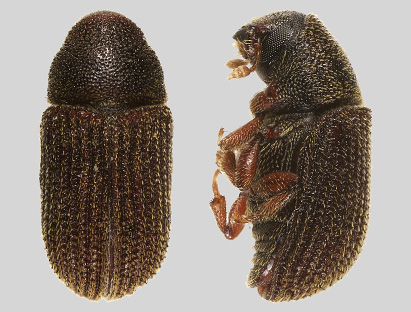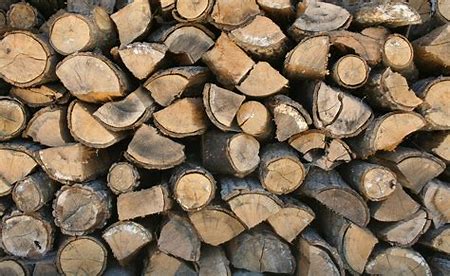Dutch Elm Disease
Dutch elm disease (DED) is an incurable and deadly fungal disease of elm trees, all of PEI's native elms being susceptible. The fungal spores enter the tree, clogging the vessels that transport water and nutrients up and down the tree. This usually kills the tree in 3 - 5 years.
Click here for detailed facts about Dutch Elm Disease.
Click here to view pictorial information about DED
|

|
How is DED spread?
Dutch elm disease can spread by elm bark beetles, through root grafts or human activity.
-
Elm bark beetles are small, shiny brownish-red beetles that are rarely visible to humans. Their activities, (egg laying, larvae feeding and overwintering), cause wounds in the elm trees. These wounds and the elm bark beetles themselves, release chemicals that attract more beetles to the elm trees. Elm trees can also have other wounds, such as pruning cuts or storm damage, which causes the tree to release a chemical that attracts the beetles. The beetles become covered with fungal spores from infected elm trees, which they spread to healthy trees as they move from tree to tree.
-
There are a number of human activities that can spread Dutch elm disease such as: moving or storing infected elm wood; pruning infected/healthy elms without cleaning pruning tools between cuts; pruning elms when elm bark beetles are active (beetles hibernate during the winter); not removing DED infected elms; and improper disposal of DED infected wood (such as firewood).
-
Tree roots from adjacent trees can connect and form grafts that allow nutrients and water to move back and forth from tree to tree. Fungal spores can be passed from tree to tree as well.
|

Larval feeding under tree bark causes fern like wounds unique to elm bark beetles.

Elm bark beetle

|
DED in Charlottetown
DED was first recorded on PEI in the late 1970's. Charlottetown has been dealing with DED since 1996 through its tree maintenance program.
The City of Charlottetown and the Province conducted a survey of public and private elms in 2014. At that time, it was found that more than half of the City's elm trees surveyed had DED.
|

Drooping, wilting, curling, yellowing or browning of the leaves at the ends of the branches (called flagging) is one symptom of DED.
Photo by Andrew Williams. |
As of 2020, 189 elm trees remain on City property and 297 on private property. This number will continue to change as the City monitors, treats and removes infected trees, as needed.
Below is a table displaying results of the 2014 private and public elm survey:
|
Healthy |
Diseased |
Dead |
Total |
| Public Land |
73 |
111 |
16 |
200 |
| Private Land |
187 |
132 |
64 |
383 |
| Total |
260 |
243 |
80 |
583 |
Infected trees could not be saved. Many of these elms were located along streets, sidewalks and in our parks where there is high pedestrian or vehicle traffic. They were also located close to residential housing and businesses. The dead elms decay, have poor structure and can become a hazard in the urban landscape.
DED, if not controlled, can quickly spread to our remaining healthy elm trees creating hazards and resulting in the loss of some of the City's largest and most beautiful trees.
Dutch Elm Disease Management

As in other municipalities, Charlottetown saw an increase in the number of DED infected trees due to stressors such as:
- Weather events, such as drought and severe storms.
- Milder winters that result in low bark beetle mortality.
- The presence of a greater number of DED infected elms in the City.
- Storage of elm wood for firewood, etc.
Unfortunately, past efforts had not stopped the spread of the disease. By applying proper management practices, it is possible to save some of the remaining elms. These elms provide numerous economic, social and environmental benefits to the city and its people.
The City consulted with other municipalities and carried out extensive research which gave the City the needed information and tools to manage DED. Key components of a successful management program include monitoring, sanitation, tree planting, communication, education and community engagement.
What Does This Mean For Privately Owned Elm Trees?
To implement a management program for DED, it is important that privately owned elm trees are monitored and diseased trees removed. If infected trees (public or private) are left in the urban forest, they will continue to spread DED, making attempts to save the healthy elm trees futile.
The City takes responsibility for all elm management on both public and private land. Here's what you need to know if you have elm trees on private property:
- American elm trees over 100cm diameter at breast height on private property are considered a Heritage tree and are protected by the City's Tree Protection Bylaw;
- All DED infected and dead elm trees will be removed, including those on private property. This work will be paid for by the City;
- You will be contacted by the City of Charlottetown if you have any elm trees on your property that are dead or diseased;
- Elm wood must be disposed of properly. If you have an elm tree removed due to DED, the City will remove all of the elm wood and dispose of it properly. No elm wood is allowed to be stored and used as firewood;
- Stump grinding will be completed for every elm removed. Any turf damage will be reinstated.
What Does This Mean For Elm Trees on Public Property?

The City is taking responsibility for all elm management on public land. Here's what you need to know about elm trees on public property:
- All DED infected and dead elm trees will be removed (public and private property);
- The City of Charlottetown does its best to notify the owners of properties in close proximity to a publicly owned elm tree that is being removed;
- Monitoring programs have been in place since 2014 that identify DED symptoms and watch healthy elms that may be at risk of being infected;
- Stump grinding is completed for every elm removed;
- The City plants trees on public property to help replace the elms that are lost to DED;
- The City squares lost a significant number of elm trees to DED. Fortunately, there are many other species of trees in our squares that will remain.
The City has been planting DED resistant elm cultivars and hybrids since 2010. Also, a wide variety of other trees species have been planted throughout the City right-of-ways and parks, which increases the biodiversity of our trees and makes the urban forest less susceptible to insects pests and diseases.
From 2010 to 2014, about 70 healthy elms were inoculated annually in an attempt to increase their resistance to DED. In 2015, The City switched to treating the healthy elm trees with a macro infusion system that included pumping a fungicide into the tree. This treatment lasts three years, so allows the City to treat healthy elm trees on a rotational basis. As of 2020, 18 of Charlottetown's large elm trees have been treated with this inoculation.
Reducing the Spread of DED
Keeping your elms healthy by providing water and fertilizer when needed and carrying out proper pruning makes your tree less stressed and more resistant to insect and disease pests.
- If you have a healthy elm tree that you would like to protect, you can hire an arborist to treat your tree to increase its resistance to DED.
- Regular monitoring of your elm trees helps to detect DED symptoms when they first appear.
- Pruning may extend the life of your elm tree but will not save it once it is infected. There is no known cure for DED. To prevent the spread of DED, the best management strategy is to remove the infected tree (in consultation with the City of Charlottetown).
- Elm species should NOT be pruned between April 1 and September 30 as these open wounds attract the elm bark beetles which spread DED.
- Timely removal and disposal of infected trees: Once DED is detected in a tree, the tree should be removed that fall/winter season, after the elm bark beetles are hibernating (after September 30). When an elm is removed, the stump should be ground and wood debris cleaned up.
- Proper disposal is important. All elm wood should be disposed of by March 31. Any elms that must be removed during the summer months (i.e. for safety reasons) must be immediately burned or buried. When transporting the wood at this time of year, it should be taken directly from the location of removal to the point of disposal.
- When planting trees, choose other resistant species or plant DED resistant cultivars of elm such as: Patriot, Pioneer, Regal, Valley Forage, Princeton, New Horizon, etc.
- One of the most important ways to prevent the spread of DED is to not store elm wood as firewood. Elm firewood provides a great habitat for the elm bark beetles to carry out their lifecycle. The more successful they are at reproducing, the more beetles are present, the more DED is spread to healthy elm trees.
As monitoring for DED continues to take place, more elms are found on private and public land. The City has completed six rounds of elm tree removals. A total of 702 DED infected elms have been removed since 2015.
Questions? Contact us at: 902-566-5548